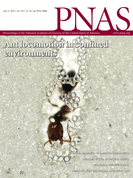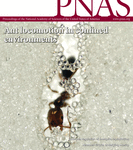 The old saying “You are what you eat” takes on new significance in the most comprehensive analysis to date of early human teeth from Africa.
The old saying “You are what you eat” takes on new significance in the most comprehensive analysis to date of early human teeth from Africa.
Prior to about 3.5 million years ago, early humans dined almost exclusively on leaves and fruits from trees, shrubs, and herbs a similar table fare to modern-day gorillas and chimpanzees. However, about 3.5 million years ago, early human species like Australopithecus afarensis and Kenyanthropus platyops began to also nosh on grasses, sedges, and succulents—or on animals that ate those plants.
Evidence of this significant dietary expansion is written in the chemical make-up of our ancestors’ teeth. These findings are reported in a series of four papers published the week of June 3 in the Proceedings of the National Academy of Sciences, by a group of international scientists spread over three continents.[1],[2],[3],[4]
“Because feeding is the most important factor determining an organism’s physiology, behavior, and its interaction with the environment, these finds will give us new insight into the evolutionary mechanisms that shaped our evolution.”
Plants can be divided into three categories based on their method of photosynthesis: C3, C4, and CAM.
C3 plants (trees, shrubs, and herbs) can be chemically distinguished from C4/CAM plants (grasses, sedges, and succulents) because the latter incorporate higher amounts of the heavier isotope carbon-13 into their tissues. When the plants are consumed, the isotopes become incorporated into the animal’s own tissues—including the enamel of developing teeth. Even after millions of years, scientists can measure the relative amounts of carbon-13 in teeth enamel and infer the amount of C3 vs. C4/CAM plants in an animal’s diet.
“What we have is chemical information on what our ancestors ate, which in simpler terms is like a piece of food item stuck between their teeth and preserved for millions of years,” said the authors
These papers represent the first time that scientists have analysed carbon isotope data from all early human species for which significant samples exist: 175 specimens representing 11 species, ranging from 4.4 to 1.3 million years in age.
The results show that prior to 3.5 million years ago, early humans ate almost exclusively C3 plants. But starting about 3.5 million years ago, early humans acquired the taste for C4/CAM plants as well, even though their environments seemed to be broadly similar to their ancestors’. The later genus Homo, including modern-day Homo sapiens, continues the trend of eating a mixture of C3 and C4/CAM plants—in fact, people who enjoy mashed potatoes with corn are practicing a 3.5 million-year-old habit.
What the studies cannot reveal is the exact identity of the food, and whether it also included animals that ate C4/CAM plants (an equally valid way to acquire carbon-13). Possible C4/CAM-derived meals include grass seeds and roots, sedge underground stems, termites, succulents, or even small game and scavenged carcasses. In 2010, Alemseged and his research team published the earliest evidence for meat consumption using tools, dating back to 3.4 million years ago—an additional line of evidence showing a dietary shift in human evolution.[5]
“The change in isotopic signal documented by the new studies, coupled with the evidence for meat-eating in Australopithecus afarensis from Dikika around 3.5 million years ago, suggests an expansion in the dietary adaptation of the species,”
The authors of this week’s papers also sampled fossils of giraffes, horses, and monkeys from the same environments and saw no significant change in their carbon isotope values over time—suggesting that the unique dietary transformation of early humans did not apply to other mammals on the African savanna. The question of what drove the transformation, however, remains unresolved.
References
[1] Wynn JG, Sponheimer M, Kimbel WH, Alemseged Z, Reed K, Bedaso ZK, Wilson JN. Diet of Australopithecus afarensis from the Pliocene Hadar Formation, Ethiopia. Proc Natl Acad Sci U S A. 2013 Jun 3. View Abstract
[2] Sponheimer M, Alemseged Z, Cerling TE, Grine FE, Kimbel WH, Leakey MG, Lee-Thorp JA, Manthi FK, Reed KE, Wood BA, Wynn JG. Isotopic evidence of early hominin diets. Proc Natl Acad Sci U S A. 2013 Jun 3. View Abstract
[3] Cerling TE, Chritz KL, Jablonski NG, Leakey MG, Manthi FK. Diet of Theropithecus from 4 to 1 Ma in Kenya. Proc Natl Acad Sci U S A. 2013 Jun 3. View Abstract
[4] Cerling TE, Manthi FK, Mbua EN, Leakey LN, Leakey MG, Leakey RE, Brown FH, Grine FE, Hart JA, Kaleme P, Roche H, Uno KT, Wood BA. Stable isotope-based diet reconstructions of Turkana Basin hominins. Proc Natl Acad Sci U S A. 2013 Jun 7. View Abstract
[5] McPherron SP, Alemseged Z, Marean CW, Wynn JG, Reed D, Geraads D, Bobe R, Béarat HA. Evidence for stone-tool-assisted consumption of animal tissues before 3.39 million years ago at Dikika, Ethiopia. Nature. 2010 Aug 12;466(7308):857-60. View Abstract





